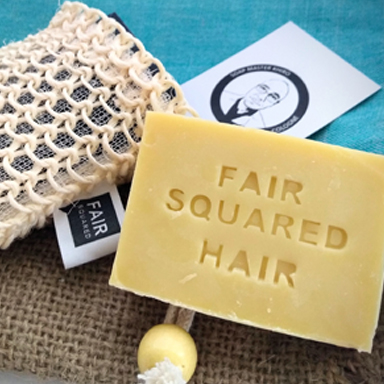

Hair cleansing soap – that’s how your switch turns out successfully
For some time now, the trend of using hair cleansing soaps is something everybody’s talking about. Not only those defining themselves as leading a zero-waste lifestyle praise the alternative to shampoos as a great innovation. Since we are personally convinced of hair soaps, we have managed to create a range of our own Fairtrade products. But let’s begin at the start and have a closer look at the backgrounds and the right way to use soap for hair cleansing.
Why should it be hair soaps? A brief introduction
Compared to liquid or solid shampoos, hair soaps cleanse by saponified oils and fats. To produce soap, a strong base is needed which converts the fats into soap within a chemical reaction. A low superfatting level remains in the soaps; this causes the hair to not get greasy too early.
Shampoos, also those which are natural cosmetics, differ in their effect: they cleanse the hair by the use of surfactants and removing the sebum from it. Solid shampoos which are often mistaken for soaps do the same. Depending on the type of surfactant, shampoos can also negatively affect scalp and hair. Dry and itching scalps can often be indicators for irritating surfactants.
Advantages of hair soaps: natural, mild hair care
Hair cleansing soaps are said to have a highly nourishing, skin and hair caring quality due to their mild composition. Furthermore, they often come without packaging and – like ours – consist of organic Fairtrade oils.
The switch from shampoo to this method may be a bit tricky, though – the hair and scalp as well as the user may need some time to get used to it.
Hair care with soaps: take your time, for you and your hair
We have already met some people saying “Whoever has switched to hair soaps, doesn’t want to go back.” This is one reason, why we have gathered some information for you which may help yourself to successfully switch, too.
From conventional shampoo to hair cleansing soaps
Whoever wants to switch to hair soaps and has before used conventional – therefore not natural cosmetical – shampoo, will surely recognize the most difficulties. Regular shampoos often contain silicone which coat the hair and cannot be rinsed out easily. While they promise to give gloss to the hair, they unfortunately cause that nourishing substances cannot get into the hair, and as result tend to dry up. In case you have used a silicone-based shampoo so far, your hair may look dull and not that shiny after turning to hair soaps at first. But: After some time, this problem will obviously be solved when your hair gets used to the new kind of care. An additional cleansing to remove the chemical substances from the hair is not needed.
Natural cosmetics: from shampoo to soap
Most people who want to switch have used natural cosmetical shampoo before. That is why they are often used to the less foamy experience that is taking place on their heads. Besides, certified natural cosmetic shampoos are not containing synthetic substances like silicones. This also simplifies switching to hair cleansing soaps.
Use of hair cleansing soaps
There exist different approaches about the “how-to” in groups of confessed “hair soap lovers”. Simply choose the method which fits your needs. The result won’t be influenced by this.
The first group of people simply takes the soap bar and rubs it directly on the wet hair until it foams enough. Then you just need to spread all the foam on your hairline, the lengths and tips, and give the scalp a soft massage.
Other users are enthusiastic about a soap peeling bag which facilitates the process of foam building. The soap inside the bag, rub it all in your hands for some time. Afterwards bring the bag to your hair and proceed to rub it.
In both cases, the hair should stay foamed for some seconds, then afterwards be rinsed out thoroughly. In some regions this may last a bit longer than with shampoo, in others you will not even notice a difference.
Speaking of:
Especially in regions with hard water: use a “sour rinse”!
If you live in a region of hard water (Cologne is an example), we recommend to pour a so-called “sour rinse” over your hair after cleansing. Just add 1–2 tablespoons of apple vinegar or lemon juice to a liter of lukewarm or cold water as a preparation. Right after you have rinsed out the foam from your hair, you give this mixture onto the hair, no need to rinse it out again. And don’t worry, as soon as your hair is dry, the vinegar smell has vanished.
That’s why it’s useful to rinse afterwards
The reason for its usefulness is that the lime in the tap water would otherwise react with the soap and so-called lime soap would be the result. This can make the hair look dull and even let it be greasy afterwards. Furthermore, the vinegar water mixture has very good conditioning qualities and brings gloss to the hair which can also be easily combed.
What should I keep in mind when …
… I dye my hair?
Usually, there is no problem to switch to hair cleansing soaps when you dye your hair. But since there are numerous hair dyes in the world, we don’t want to guarantee that everything will be fine with our FAIR SQUARED hair cleansing soaps. To check that, please contact your hairdresser and ask him about basic ph value hair care products and your specific dye.
… I often go swimming?
We personally have never come across any problems with chlorine in swimming pools. Therefore you and your hobby should not get into conflict with the usage of hair soaps.
… I tend to have an itching, quite sensitive scalp?
If that is something you are heading at the moment, we recommend you to try hair soaps instead. Often, itchy spots and a non-balanced production of sebum can be effects of too irritating surfactants in your shampoo. We personally know people who have chosen to switch just because of this and are now absolutely content. So why not just give it a try?
18. November 2019
